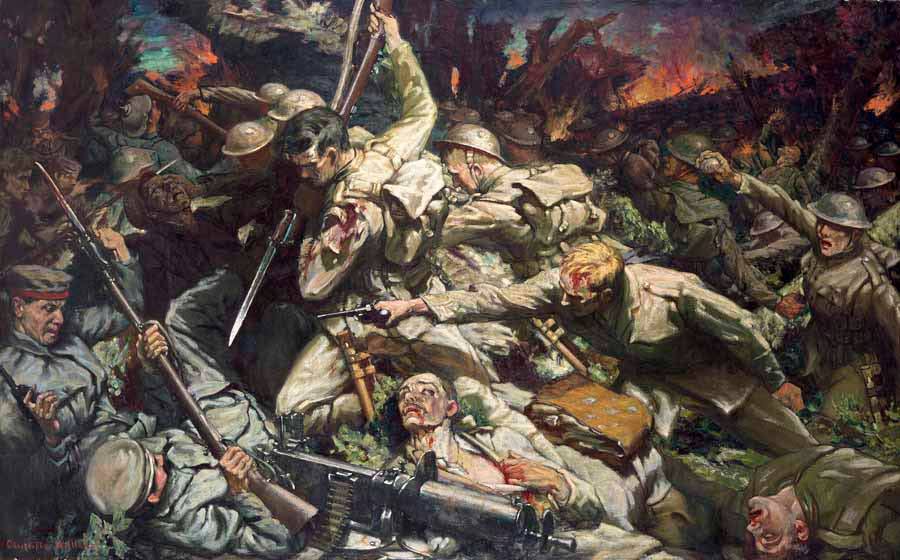The Battle of Mametz Wood raged from July 7th to 12th, 1916 — and even the Ancient Borough of Kidwelly had a connection…
William Bowry and David Morris Davies, both from Kidwelly, were part of the 38th (Welsh) Division’s assault on Mametz Wood in July 1916. William saw that brutal battle and later died in 1918, while David fought at Mametz, was wounded at Ypres, and passed away in 1917.
William Bowry
originally from London, William worked locally as a cowman before enlisting at Llanelli into the South Wales Borderers. He later transferred to the 16th Battalion, Royal Welsh Fusiliers (part of 113 Brigade, 38th Division). He marched to the Somme in June 1916 and fought at Mametz Wood in July. William survived the Somme but was killed on 26 August 1918 during later fighting, from the 1911 Census William was working for David Griffiths of Llechdwnny Farm, Llandyfaelog.
David Morris Davies
Born in Kidwelly in 1896 and the son of David and Ceridwen Davies. He enlisted in the 16th Battalion, Royal Welsh Fusiliers, which was part of the 38th Division at Mametz Wood. David was wounded later at Ypres and died of his wounds on 7 August 1917 in Hampshire. He is buried at Siloam Welsh Baptist Chapel, Kidwelly, from the 1911 Census David was living at Mount Pleasant, Ferry Rd, he was working at The Tin Plate Works on the cold rolls.
(Painting Credit.. Christopher Williams (1873-1934), The Welsh Division at Mametz Wood, 1916, reproduced courtesy of National Museum of Wales from the Peoples Collection of Wales)

Here’s a comprehensive overview…
⸻
![]() 1. Background & Objectives
1. Background & Objectives
• The 38th (Welsh) Division, formed largely from volunteers across Wales in late 1914, was part of Kitchener’s “New Army” and first deployed to France in late 1915 .
• In early July 1916, their orders were to capture Mametz Wood—a vital German stronghold—so the Fourth Army could advance to the ridge beyond .
⸻
![]() 2. Initial Attacks: 7–9 July
2. Initial Attacks: 7–9 July
• On 7 July, two battalions (the 16th Welsh and 10th SWB) attacked but were halted by intense machine‑gun and artillery fire, suffering approximately 400 casualties just before reaching the wood .
• Follow‑up efforts, including by the 17th Division on 8 July, achieved little .
⸻
![]() 3. Leadership Changes & Major Assault
3. Leadership Changes & Major Assault
• High command, including Haig and Rawlinson, deemed the division’s progress insufficient. As a result, Major-General Ivor Philipps was replaced by the more experienced Major‑General Herbert Watts on 9 July .
• A major attack was launched on 10 July, supported by heavy artillery. This breached the wood’s outskirts despite fierce resistance, triggering brutal hand‑to‑hand combat .
⸻
![]() 4. Victory & Casualties: 11–12 July
4. Victory & Casualties: 11–12 July
• After continued fighting, the Germans withdrew, and by 12 July the division secured Mametz Wood .
• But at a terrible cost: around 4,000 casualties, with over 600 killed .
• Specific losses included the 14th (Swansea) Welsh: started with 676 men, lost nearly 400 in one day .
⸻
![]() 5. Evaluation & Legacy
5. Evaluation & Legacy
• Some contemporaries criticized the division, alleging panic or failure; those views are now regarded as unfair given the circumstances ().
• Historians now see their performance as courageous and determined under grueling conditions, describing the fight as “a gruesome baptism of fire” ().
• The event inspired notable art and literature: Christopher Williams painted The Welsh at Mametz Wood (1917) at Lloyd George’s request . Poets like David Jones and Owen Sheers also drew on the experience .
⸻
![]() 6. Memorial Today
6. Memorial Today
• A powerful red dragon memorial by David Petersen, placed on a stone plinth facing the wood, was unveiled in 1987. It commemorates the Welsh Division’s sacrifices .
• Each July, remembrance services are still held at the site, acknowledging the 4,000-plus Welsh lives affected ().
⸻
In Summary
• The 38th (Welsh) Division’s capture of Mametz Wood was a strategic victory steeped in tragic human cost.
• Their struggle highlighted both the hardships of trench warfare and the determination of volunteer soldiers facing brutal combat.
• Over time, initial criticisms have been replaced by pride and reverence. The division’s actions at Mametz now symbolize the bravery and sacrifice of Wales during WWI.
